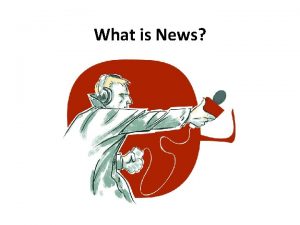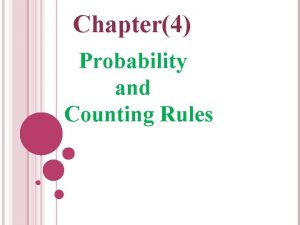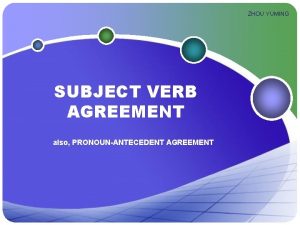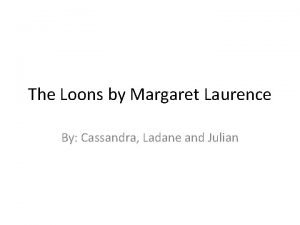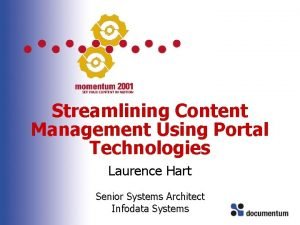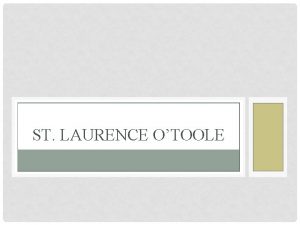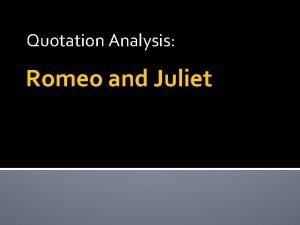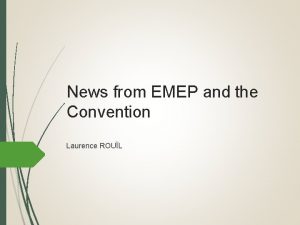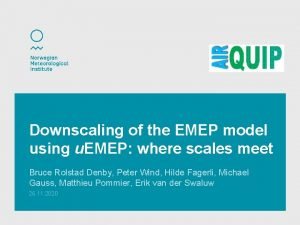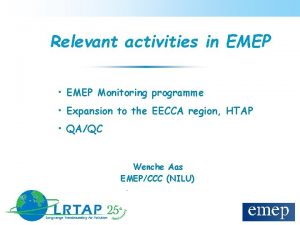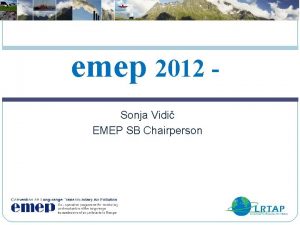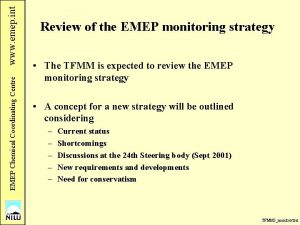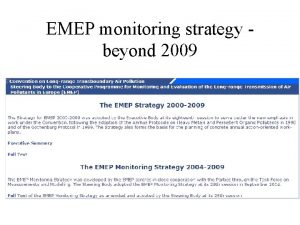News from the Convention and EMEP Laurence ROUL









- Slides: 9

News from the Convention and EMEP Laurence ROUÏL – Chair of the EMEP Steerring Body

Last meetings 3 rd joint EMEP SB/WGE joint meeting –September 2017 o Adoption of the new 2018 -2019 workplan o First review of the recommendations of the Policy Response Group (PRG) set by the WGSR to highlight strategic priorities from the 2016 assessment end trends reports o Review of the Task forces and EMEP centers mandates that will be formally adopted by the EB in December 2018 Executive body Meeting – December 2017 o Review and Adoption of the PRG recommendations (130) as inputs for the review of the long term strategy EMEP/WGE Joint Bureaux meeting – February 2018 (Madrid hosted by CIEMAT) o Improving EMEP/WGE cooperation o Outreach issues o Improving communication, visibility and dissemination of the results and data provided by the Convention o Financial issues (how to increase interest of the Parties to support scientific work under the Convention) o Future of the WGE/CCE Saltsjöbaden VI workshop organized by the Swedish EPA in March 2018 (Gothenburg) o Review of future strategic priorities for the Convention and air pollution policies

Key messages from Saltsjöbaden VI (i) 1. Flexibility for parties in the Eastern region Why : creating new momentum for the ratification of the protocols Action: explore possibility to allow for step-wise ratification in preparation for a future review of the Gothenburg Protocol. Initiators: EECCA contact group/WGSR EB, IC 2. Clean air in cities (in-reach) Why : cities are where health exposure to air pollution is the highest and are sources as well Action: set up an expert panel under TFIAM to support local air policy. Initiators: EMEP/EB-decision Parties TFIAM/TFH/TFMM Urban platforms, cities 3. Global air quality monitoring network why: several global initiatives (WHO, UNEP, WB, CCAC) that can be supported by the Convention tools Action: take initiative for global harmonized monitoring network, including emission inventories and projections. Initiators: HTAP/TFMM/WMO/AMAP WB/IPCC 4. Global air policy dialogue Why : need to increase awareness at the global scale and set-up a global policy framework for air pollution Action: start joint cross-institutional air pollution policy dialogue and information-sharing platform. Initiators: EB Bureau UN-Env WHO, WMO, AMAP, WB, …

Key messages from Saltsjöbaden VI (ii) 5. Better ecosystem monitoring Why: increasing need to monitor long term effects of air pollution on ecosystems (specific article in the revised NEC Directive) Action: set up an expert group to coordinate and harmonize the monitoring of ecosystem effects for various conventions. Initiators: WGE/EU-COM CBD, TEEB 6. Reduce ships emissions Why: one of the main sources of air pollutants that have not been targeted yet by ambitious policies Action: encourage maritime emission control areas in all seas and develop schemes to reduce emissions from existing ships. Initiators: Parties HELCOM/OPSARCOM/REMPEC, EU-COM 7. Reduce domestic heating emissions why: one of the most sensitive issues regarding for PM air pollution causes in Europe Action: address health impacts of domestic solid fuel burning and develop schemes for replacement and awareness-raising. Initiators: TFTEI WGSR/WHO UN FCCC, Parties, Urban platforms 8. Reduce agricultural nitrogen losses Why: nitrogen (and ammonia emissions) remains one of the most sensitive issue regarding air pollution in Europe. Impacts on both human health and ecosystems. Action: develop criteria to link agricultural subsidies to emission reduction obligations. Initiators: TFRN/EU-COM Parties

Specific messages for the TFMM The city scale is relevant for the work of the Convention : EMEP develops tools to assess the contribution of long range transport to urban air pollution exposure Need to characterize linkages between urban/regional/global air pollution for conceiving efficient control strategies : for instance local policies need sectoral regulations (EURO 7 ? ; wood stoves regulations …) to be really efficient Coordination of EMEP and WGE monitoring and modelling activities is essential to define and assess future air pollution policies driven by the effects q The fact that UBA Germany will host the new CCE is now confirmed q Discussions currently on-going between UBA and RIVM for the transfer of the database, its content and associated tools q Need to reinforce linkages between TFMM and ICP Modelling and Mapping to promote use of EMEP input data in critical loads calculations

Outreach issues On-going discussions with UNEP for the implementation of the UNEA 3 resolution on global air pollution : so far no concrete action but exchange of information about the tools and the achievements reached in various areas. The CLRTAP is a successful and inspiring story … Cooperation with AMAP in the framework of a EU contract on black carbon impact in the Arctic. First step concerns emissions and monitoring aspects. CEIP and CCC are involved. Cooperation with AMAP and the Minamata Convention on Mercury (MSC-E) Cooperation with the Stockholm Convention on POPs for contributing to assessment report (MSC-E) Cooperation with Copernicus/CAMS for the provision of NRT observation data (CCC). Governance questions related to the NRT dataflows remain to be discussed with ECMWF

Securing EMEP and WGE activities Funding aspects remain sensitive since voluntary contributions from the Parties are quite low and the EMEP budget is not sufficient to cover the tasks set in the mandates and expected in the work plan New ways to involve the Parties should be proposed : q Contribution to and/or coordination of scientific studies under the task forces q Developing tools and data for which Parties are willing to pay A review of the use of data produced by the Convention must be performed by EMEP and WGE: a questionnaire should be sent before June to the representatives of the WGSR to know more about the way data from the Convention is used, and what is expected in the future. Task forces representatives should be consulted through WGSR delegates

Sensitive questions and priorities of the work plan Condensable in PM: cooperation between TFMM and TFEIP to define a methodology to account for this « unknown » part of PM A sectoral approach may be defined Recommendations and inputs from emission community is essential for the modelers A strategy must be presented during the EMEP SB meeting in September since it covers both policy and scientific aspects To be linked with the activities on residential wood burning that will developed under the Convention The EMEP monitoring strategy Should be revised in 2019 (with the EMEP strategy) Must reflects needs highlighted by the PRG recommendations and constraints (budget) in the Parties Must be aligned, if possible, with effect monitoring strategies Emission inventories and adjustment applications reviews under the NEC and CLRTAP Two distinct processes that should not lead to different conclusions The guidelines must be aligned and the reviews planned to optimize resources and avoid duplication of work Updates of the current guidelines will be necessary

Next steps Revisions of EMEP and WGE strategies According to the CLRTAP long term strategy and the priorities set by the Parties A common document (EMEP and WGE) including the EMEP monitoring strategies may be drafted First presentation at the EB in December 2018 Next EMEP/WGE joint meeting : 11 -14 September 2018 with thematic sessions on Mercury and heavy metals on one side and on ammonia and nitrogen impacts on the other side Formal adoption of the mandates of the TFs and EMEP Centers in December 2018
